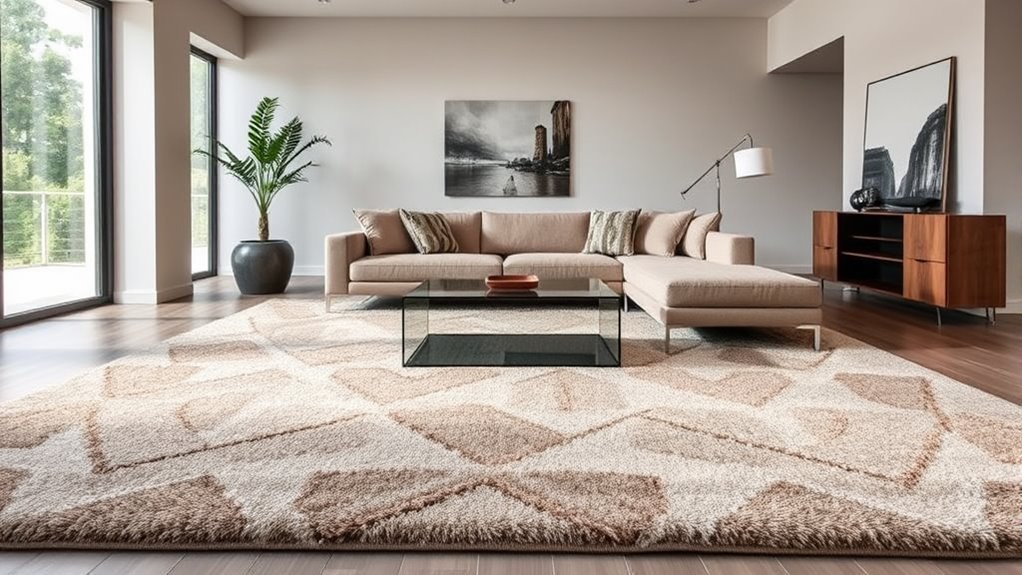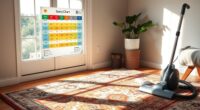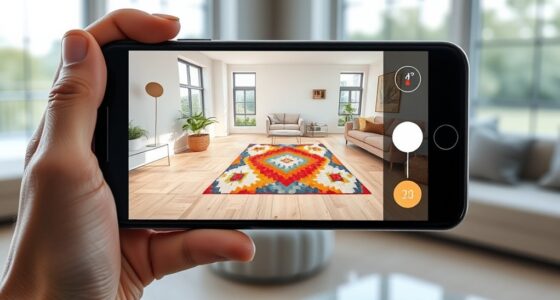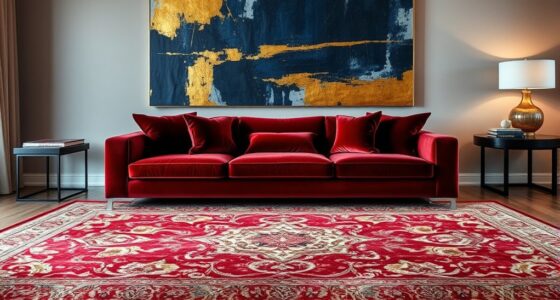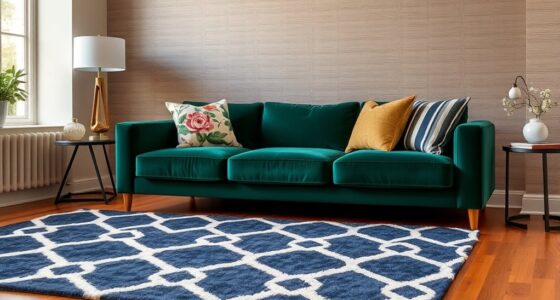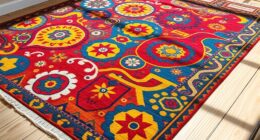To perfect your rug size and placement, measure your space carefully, leaving 12-18 inches of floor around it. Choose a rug that fits your furniture layout, with furniture legs partly or fully on the rug for visual balance. Use borders to define areas, layer rugs for interest, and consider traffic flow to avoid clutter. Play with colors, patterns, and proportions to highlight features—keep exploring to make your space look even better.
Key Takeaways
- Measure room dimensions and furniture to select a rug that balances space and scale.
- Ensure the rug extends 6-12 inches beyond furniture legs for proper proportion.
- Position furniture partly or fully on the rug to create visual harmony and zone definition.
- Use borders and layered rugs to define spaces and add depth in open-plan layouts.
- Consider traffic flow by avoiding placement in main walkways and high-traffic areas for safety.
Measure Your Space Carefully Before Shopping

Before you start shopping for a rug, it is vital to measure your space accurately. Use a tape measure to determine the length and width of the area where you plan to place the rug. Remember, the right size enhances your room’s appearance and comfort. Keep in mind that larger area rugs can anchor furniture and define spaces, while smaller ones add subtle accents. Don’t forget to contemplate rug padding; it provides extra cushioning, prevents slipping, and extends the rug’s lifespan. Measure with precision, accounting for furniture placement and walkways. This step guarantees you select a rug that fits perfectly, avoiding awkward gaps or overcrowding. Accurate measurements guide you toward choosing an ideal size that maximizes space efficiency and complements your space beautifully, especially when considering decor style and room layout. Additionally, considering the indoor aesthetics can help you choose a rug size that enhances your overall interior design. Taking into account interior design principles can further ensure your rug complements your existing decor.
Choose the Right Rug Size for Your Room’s Layout
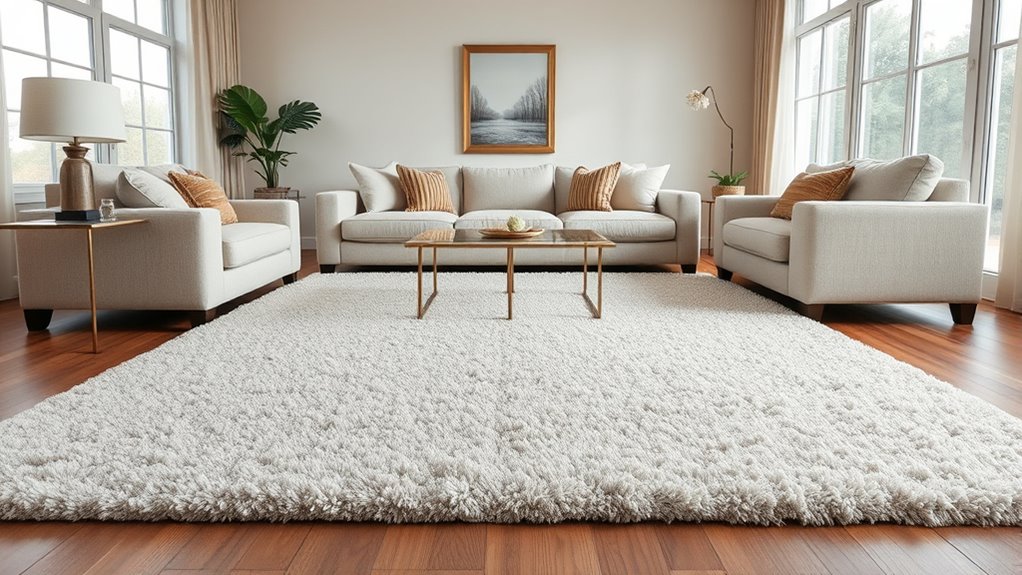
Choosing the right rug size depends on how you use your space and how your furniture is arranged. You want the rug to complement the room’s flow without making it feel crowded or disconnected. You may also want to consider the symbolism associated with certain patterns or designs to enhance your room’s ambiance. Incorporating wall organization systems can help you visualize the space and determine the most balanced rug placement. Additionally, selecting a rug size that suits the room dimensions ensures an aesthetically pleasing layout and comfortable environment. Leveraging machine learning algorithms can assist in designing optimal layouts by analyzing space features, helping you make more informed decisions. Understanding interior design principles can further guide you in creating a cohesive and inviting space. Keep these factors in mind to guarantee your rug enhances both function and style.
Room Functionality & Flow
The size of your rug can considerably influence how your room functions and flows, so selecting the right dimensions is key to creating a balanced space. A well-chosen rug anchors your furniture and defines zones, making movement smooth and natural. To enhance room functionality, consider color coordination; a rug that complements your wall colors or furniture creates cohesion, while contrasting shades can highlight specific areas. Material selection also impacts flow—soft, plush rugs work well in cozy spaces, while low-pile options suit high-traffic areas. Proper sizing ensures pathways remain clear and furniture placement feels intentional. Overall, balancing rug size with your room’s layout and function helps create a welcoming, organized environment that invites easy movement and visual harmony.
Furniture Arrangement Compatibility
Selecting the right rug size depends heavily on how you arrange your furniture within the space. You want a rug that complements your layout, enhances color coordination, and supports material durability. For example, a larger rug can unify seating areas, while a smaller one works well with accent chairs. Consider the following:
| Furniture Type | Rug Size Recommendation | Material Tips |
|---|---|---|
| Sofa & Coffee Table | Big enough to fit all legs | Choose durable, stain-resistant fabrics |
| Lounge Chairs | Slightly smaller than furniture | Opt for easy-clean materials |
| Dining Table | Extends beyond table edges | Use sturdy, wear-resistant fibers |
Matching rug size to your furniture arrangement ensures harmony, making your space both functional and stylish. Additionally, selecting appropriate materials can enhance the longevity and appearance of your rug over time. Incorporating space planning principles can further optimize your room’s layout and comfort, especially when considering furniture placement for both style and practicality. Proper relationship dynamics can also influence how you choose and position your rug to create a welcoming environment.
Keep Furniture Legs on or Off the Rug? When in Doubt, Follow the Rule

When deciding whether to keep furniture legs on or off the rug, following a simple rule can save you from guesswork: if you’re unsure, let the furniture sit partly or entirely on the rug. This approach ensures balanced furniture leg positioning and helps maintain proper rug edge alignment. If the furniture is too far off the rug, it can create a disjointed look; if it’s too far on, the rug might seem too small. Generally, having the front legs of your sofa or chairs on the rug creates a cohesive, anchored feel. Keep in mind that the goal is to create visual harmony, so adjusting furniture placement to ensure consistent furniture leg positioning relative to the rug is key. When in doubt, let the furniture partly sit on the rug for a polished look. Additionally, maintaining proper rug size and placement can further enhance the overall aesthetic and balance of your space. Being aware of store hours can also help you plan your shopping trips efficiently when selecting the right rug size and style. Incorporating SQA best practices into your design process can ensure your choices are both functional and visually appealing. A helpful tip is to consider the different rug shapes available to complement various furniture arrangements and room layouts.
Use a Border for Defined, Cohesive Areas
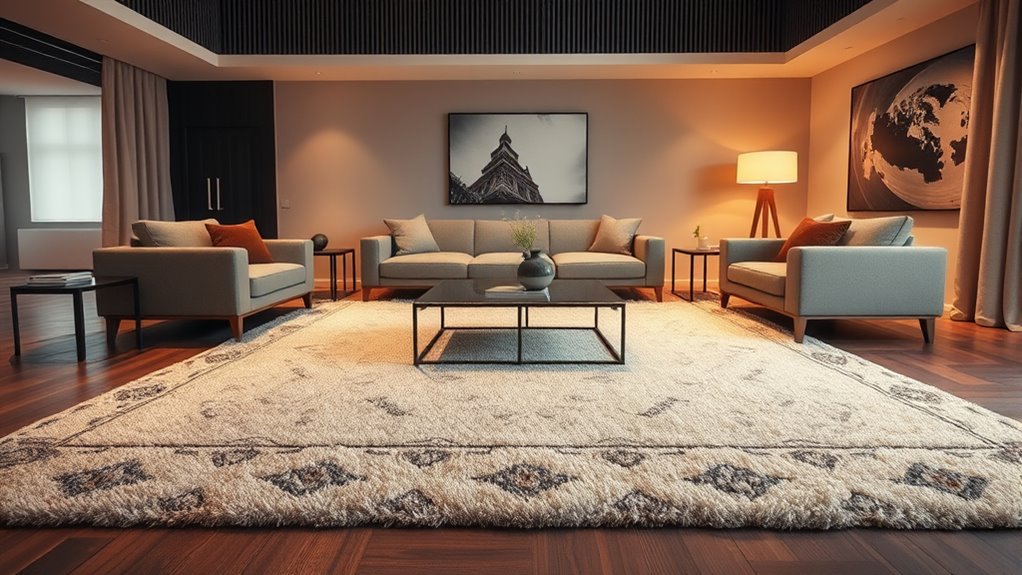
Adding a border around your rug can instantly define a space and create a cohesive look. A well-chosen border adds clear border definition, visually setting apart a rug from surrounding flooring. This technique helps establish cohesive zones within your room, making the area feel intentional and organized. Borders can be simple or elaborate, depending on your style, and they work especially well in open-plan spaces where boundaries need clarification. By framing your rug, you create a visual anchor that ties furniture and decor together seamlessly. A border also enhances the overall harmony of your room, giving it a polished, finished appearance. Whether you select contrasting colors or subtle accents, a border is a simple yet effective way to elevate your space’s design.
Balance Rug Placement With Room Proportions

To achieve a balanced look, start by measuring your room carefully to understand its proportions. Use furniture to gauge scale and guarantee the rug complements the space without overwhelming it. Maintaining visual harmony makes your room feel cohesive and well-designed.
Measure Room Dimensions Carefully
Accurately measuring your room’s dimensions is essential to achieving a balanced rug placement. Start by measuring the length and width of your space, noting any architectural features like doorways or built-ins that could influence rug placement. When selecting area rugs, consider how much of the floor you want visible around the edges—typically, 12 to 18 inches works well. Proper rug padding is also key; it not only protects your flooring but helps keep the rug in place, especially in high-traffic areas. Taking precise measurements ensures your rug complements the room’s proportions, avoiding a look that feels cramped or awkward. Remember, a well-measured rug enhances your space’s overall harmony and makes your furniture placement feel intentional and balanced.
Maintain Visual Balance
Once you’ve measured your room carefully, focus on how the rug interacts with the space’s proportions. To maintain visual balance, choose a rug that complements the room’s size—too small, and it’ll look out of place; too large, and it can overwhelm the space. Pay attention to color harmony, selecting a rug that enhances the room’s palette without clashing. Pattern coordination is equally important: if your furniture and walls feature bold designs, opt for a more subdued rug, or vice versa. A well-balanced rug anchors the room, creating a cohesive look. Ensuring the rug’s size and pattern work in harmony with your room’s proportions helps achieve a visually pleasing, balanced environment that feels inviting and well-designed.
Use Furniture for Scale
Using furniture as a reference point helps you achieve a balanced rug placement that complements your room’s proportions. This approach guarantees the rug’s size aligns with your furniture proportion, creating harmony. To do this effectively, consider these steps:
- Measure your furniture’s scale reference—like a sofa or coffee table—to determine the ideal rug size.
- Ensure the rug extends beyond furniture legs, typically 6-12 inches, for a cohesive look.
- Balance the room by matching the rug’s dimensions with the overall space, so it doesn’t overpower or get lost.
Layer Rugs for Depth and Visual Interest

Layering rugs adds both depth and visual interest to your space, creating a dynamic and inviting atmosphere. By layer rugs, you can combine different textures, patterns, and sizes, which draws the eye and makes the room feel more curated. Start with a larger rug as a base, then add smaller rugs on top to highlight specific areas or add contrast. This technique works well in living rooms, bedrooms, and entryways, giving each space a personalized touch. Keep in mind that layering should enhance, not overwhelm, the room’s design. Balance the colors and patterns to avoid clutter. When done thoughtfully, layering rugs transforms a simple space into a rich, textured environment full of character and charm.
Consider Traffic Flow to Prevent Clutter and Tripping Hazards
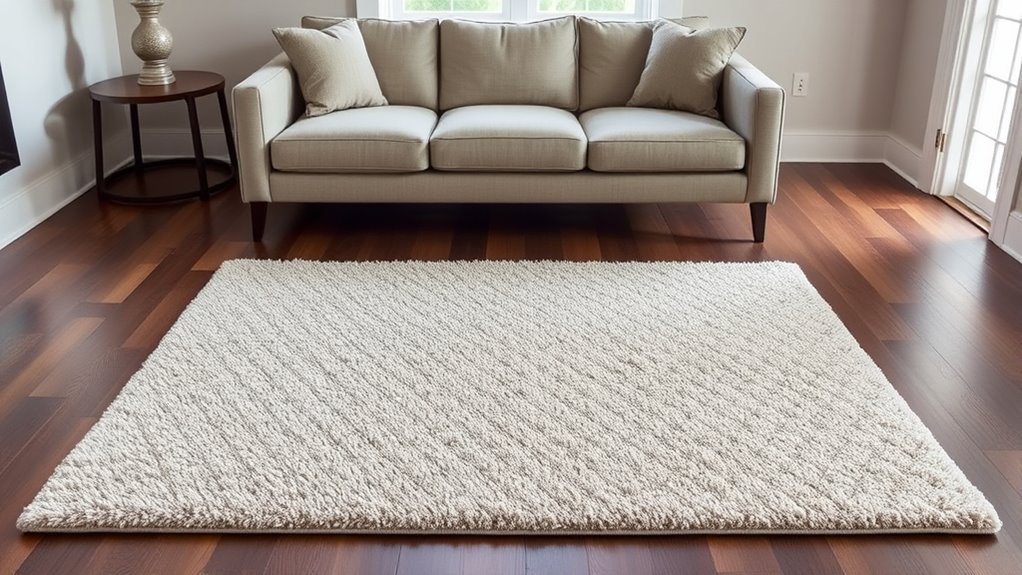
Before placing rugs, it’s essential to evaluate how foot traffic will move through the space. Proper traffic considerations ensure safety and prevent clutter. To do this effectively:
Assess foot traffic patterns first to ensure safe, clutter-free rug placement.
- Identify main walkways to keep rugs clear and avoid tripping hazards.
- Position rugs so they don’t block doorways or high-traffic areas.
- Make sure rugs are large enough to anchor furniture without creating crowded pathways.
Use Color and Pattern to Guide Placement and Focus
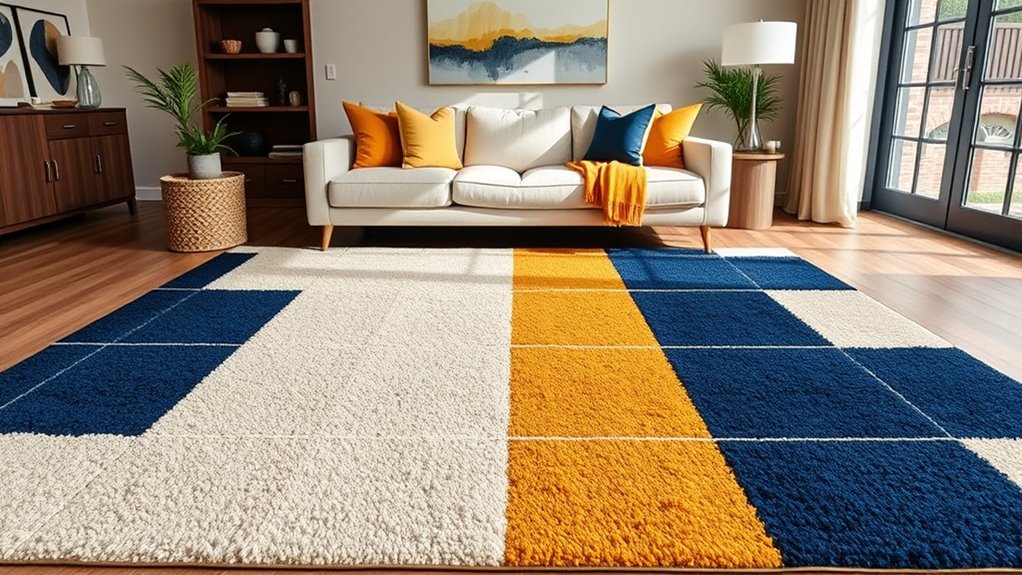
Color and pattern are powerful tools that can direct attention and define the flow of your space. By using intentional color coordination, you can draw focus to specific areas, making rooms feel more cohesive. For example, a rug with bold hues or contrasting shades can anchor a seating area or highlight a focal point. Pattern mixing is equally effective; pairing a patterned rug with solid furniture creates visual interest without overwhelming the space. Keep patterns balanced—if your rug features intricate designs, opt for simpler furniture and accessories. Conversely, a subtle rug can serve as a backdrop for more vibrant decor. Thoughtful use of color and pattern not only guides placement but also enhances the overall harmony and focus within your room.
Adjust Rug Positioning to Highlight Architectural Features
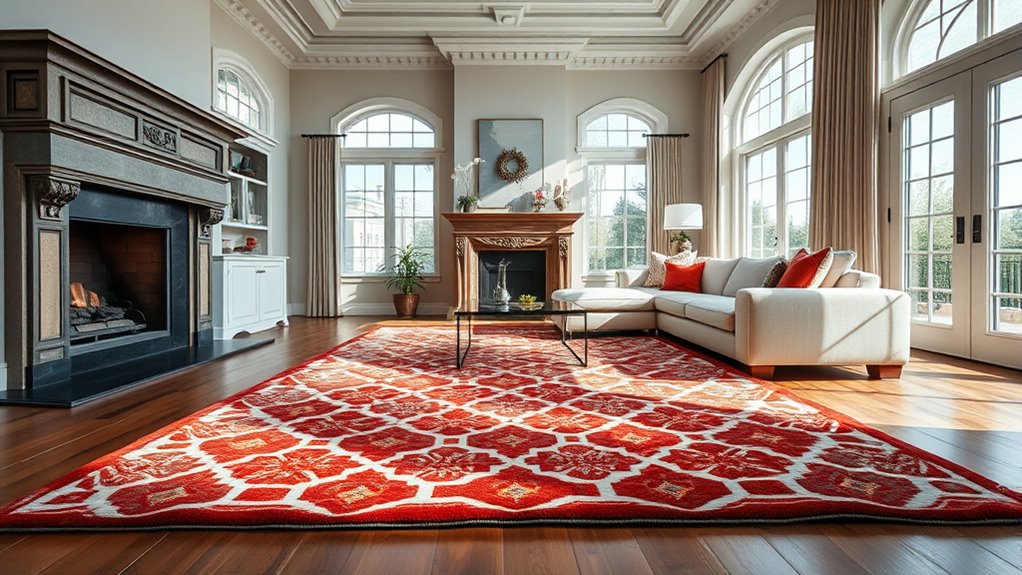
To emphasize architectural features with your rug, you need to carefully adjust its placement so that it draws attention to key elements like fireplaces, built-in shelving, or unique flooring details. Proper positioning highlights these focal points and enhances your room’s architectural accents. Consider these steps:
Strategically position your rug to highlight fireplaces, built-ins, and unique flooring details effectively.
- Center the rug over focal points, ensuring it frames the feature without overpowering it.
- Push the rug closer to key elements, like a fireplace, to create a visual connection.
- Align the edges of the rug with architectural lines, such as wall angles or molding, to emphasize design details.
Frequently Asked Questions
How Do I Choose a Rug That Complements Existing Decor?
When choosing a rug that complements your existing decor, focus on color coordination and style harmony. You want the rug to blend seamlessly with your furniture and walls, so pick a color palette that matches or contrasts subtly. Consider your decor style—modern, traditional, or eclectic—and select a rug that enhances that vibe. This way, your space feels unified and thoughtfully curated, making your room look polished and inviting.
What Is the Best Rug Placement for Open-Concept Spaces?
In open-concept spaces, you should position your area rugs to define different zones, like your seating area or dining space. Layering rugs adds depth and visual interest, so consider placing a larger rug underneath furniture and layering smaller ones for style. Make sure rugs are proportionate to the space and furniture, creating a cohesive look. Proper placement enhances flow and makes your open area feel inviting and well-designed.
How Can I Make a Small Room Appear Larger With Rugs?
Did you know that a well-chosen rug can make a small room seem 30% larger? To achieve this, opt for rugs that coordinate with your wall color for a seamless look. Use light colors and minimal patterns to open up the space visually. Keep the rug proportionate to the room size, and place it so that it unifies furniture. This simple trick creates an airy, expansive feel.
Should Rugs Be Centered or Offset in Asymmetrical Rooms?
In asymmetrical rooms, you should consider using rugs as art by intentionally offsetting or centering them for visual interest. Offset placement can highlight contrasting textures and create a dynamic look, while centering offers balance. Think about how the rug interacts with your furniture and space. You want the rug to complement and enhance the room’s aesthetic, making it feel curated and engaging, regardless of symmetry.
How Do I Maintain Rug Placement Over Time?
To keep your rug in place over time, regularly check its placement and make small adjustments as needed. For rug maintenance, vacuum frequently and rotate it seasonally to prevent uneven wear. Use non-slip pads or rug grippers to secure it on smooth surfaces, reducing movement. If you notice shifting, reposition and add extra grip aids to maintain your desired placement and keep your space looking polished.
Conclusion
By applying these designer tricks, you’ll create a perfectly balanced and inviting space. Did you know that a well-placed rug can make a room feel up to 20% larger? With careful measurement, thoughtful sizing, and strategic placement, you’ll transform any room into a stylish sanctuary. Trust your eye, experiment a little, and enjoy the process—your ideal rug setup is just a few expert tips away!
